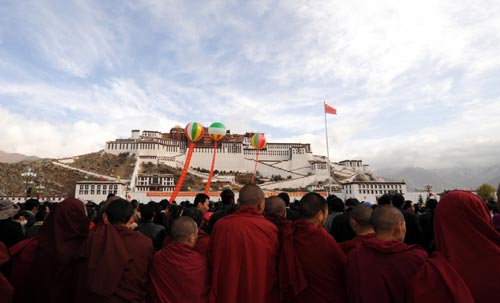|
|

People gather at the square of the Potala Palace to celebrate the Serfs Emancipation Day in Lhasa, southwest China's Tibet Autonomous Region, March 28, 2010. Nearly 3,000 people gathered at the Potala Palace celebrating the Serfs Emancipation Day in the form of raising flag and playing national anthem. [Xinhua] |
Tibet holds flag hoisting ceremonies only on significant festivals and occasions such as the National Day and the Tibetan new year. At other times, the national flag flies high in the square.
Many organizations, companies, schools, residential communities and individuals in both cities and rural areas joined in the flag raising Sunday morning.
For centenarian Cering Qoezhoen, raising the national flag has been a daily habit for the past 45 years.
"I just want to express my sincere gratitude to the communist Party of China and the People's Liberation Army in this way," said Cering Qoezhoen who was a porter serf when she was young.
China designated March 28 as annual Serfs Emancipation Day last year to mark the date on which about 1 million serfs in the region, accounting for more than 90 percent of the Tibetan population, were freed in 1959.
Since then, Tibetans have achieved remarkable development and no reactionary forces can block Tibet's progress, said Padma Choling, chairman of Tibet Autonomous Regional Government, on Saturday.
"The Tibetans cherish the hard-won, happy and stable life and will steadfastly safeguard social stability, ethic unity and national unity. Any attempt to separate Tibet from China is doomed to failure," he said while delivering a televised speech.
|



